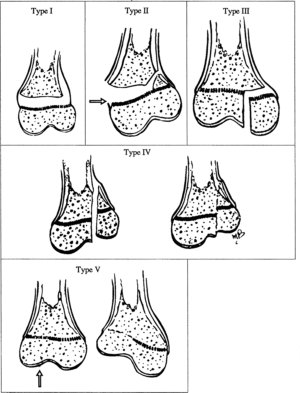|
Salter-Harris FracturesSalter-Harris fractures belong to a specific classification of pediatric fractures which can occur in children during their bone growth years. These injuries are unique because the vast majority involve the areas of bones where the actual growth occurs; the growth plates.
The entire Salter-Harris fracture classification system is built around the mechanism of injury, location of the fracture, as well as the extent of involvement of the growth plate.
There is little to no calcified, or hardened, bone located in the active areas of the growth plate, and consequently do not reflect x-ray beam penetration. That is why, on x-ray examination, growth plates will look like “spaces”, or even fracture lines when compared to the surrounding, hardened calcified bone. It is not unheard of that growth plates can be mistaken for fracture lines in children who are at the age where growth plates begin to close, or “fuse”.
Injuries to these plates or “physes” can occur long before breakage of the more mature, hard bone occurs, as is seen in the shafts of long bones.
Once the classification system is understood, merely describing an injury as a “Salter-Harris type I” or “type IV” immediately gives reference to the nature of the fracture and how it involves the corresponding growth plate.
For Type I fractures, Click Here For Type II fractures, Click Here For Type III fractures, Click Here For Type IV fractures, Click Here For Type V fractures, Click Here
Leave Salter-Harris Fractures, Go to Fractures
|

"We hope you enjoy your journey through Bone and Joint Pain.com"

